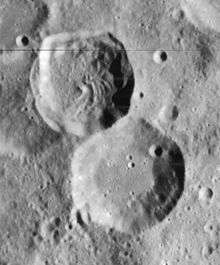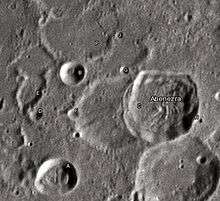Abenezra (crater)
Abenezra is a lunar impact crater located in the rugged highlands in the south-central section of the Moon. Abenezra is named after the Sephardic Jewish sage, poet, biblical commentator, astronomer, and astrologer Abraham ibn Ezra,[1] It is attached along the southeast rim to the crater Azophi. To the northeast lies the crater Geber, and further to the southeast is the larger Sacrobosco.
 Lunar Orbiter 4 image of Abenezra crater (upper left) and Azophi crater (lower right) | |
| Coordinates | 21.0°S 11.9°E |
|---|---|
| Diameter | 42 km |
| Depth | 3.7 km |
| Colongitude | 349° at sunrise |
| Eponym | Abraham ibn Ezra |

The rim of Abenezra has a noticeably polygonal shape, with uneven wall segments. The inner walls are terraced, and the floor is irregular and ridged. These ridges form unusual, sinuous patterns across the floor. The crater overlays the eastern part of another crater-like formation designated Abenezra C.
Satellite craters

By convention these features are identified on lunar maps by placing the letter on the side of the crater midpoint that is closest to Abenezra.
| Abenezra | Latitude | Longitude | Diameter |
|---|---|---|---|
| A | 22.8° S | 10.5° E | 23 km |
| B | 20.8° S | 10.1° E | 14 km |
| C | 21.3° S | 11.1° E | 44 km |
| D | 21.7° S | 9.7° E | 8 km |
| E | 21.4° S | 9.4° E | 14 km |
| F | 21.5° S | 10.3° E | 7 km |
| G | 20.5° S | 11.0° E | 5 km |
| H | 21.1° S | 12.8° E | 4 km |
| J | 19.9° S | 10.7° E | 5 km |
| P | 19.9° S | 9.9° E | 44 km |
References
- "Abenezra". Gazetteer of Planetary Nomenclature. USGS Astrogeology Research Program.
- Andersson, L. E.; Whitaker, E. A. (1982). NASA Catalogue of Lunar Nomenclature. NASA RP-1097.CS1 maint: ref=harv (link)
- Bussey, B.; Spudis, P. (2004). The Clementine Atlas of the Moon. New York: Cambridge University Press. ISBN 978-0-521-81528-4.CS1 maint: ref=harv (link)
- Cocks, Elijah E.; Cocks, Josiah C. (1995). Who's Who on the Moon: A Biographical Dictionary of Lunar Nomenclature. Tudor Publishers. ISBN 978-0-936389-27-1.CS1 maint: ref=harv (link)
- McDowell, Jonathan (July 15, 2007). "Lunar Nomenclature". Jonathan's Space Report. Retrieved 2007-10-24.CS1 maint: ref=harv (link)
- Menzel, D. H.; Minnaert, M.; Levin, B.; Dollfus, A.; Bell, B. (1971). "Report on Lunar Nomenclature by the Working Group of Commission 17 of the IAU". Space Science Reviews. 12 (2): 136–186. Bibcode:1971SSRv...12..136M. doi:10.1007/BF00171763.CS1 maint: ref=harv (link)
- Moore, Patrick (2001). On the Moon. Sterling Publishing Co. ISBN 978-0-304-35469-6.CS1 maint: ref=harv (link)
- Price, Fred W. (1988). The Moon Observer's Handbook. Cambridge University Press. ISBN 978-0-521-33500-3.CS1 maint: ref=harv (link)
- Rükl, Antonín (1990). Atlas of the Moon. Kalmbach Books. ISBN 978-0-913135-17-4.CS1 maint: ref=harv (link)
- Webb, Rev. T. W. (1962). Celestial Objects for Common Telescopes (6th revised ed.). Dover. ISBN 978-0-486-20917-3.CS1 maint: ref=harv (link)
- Whitaker, Ewen A. (1999). Mapping and Naming the Moon. Cambridge University Press. ISBN 978-0-521-62248-6.CS1 maint: ref=harv (link)
- Wlasuk, Peter T. (2000). Observing the Moon. Springer. ISBN 978-1-85233-193-1.CS1 maint: ref=harv (link)
External links
| Wikimedia Commons has media related to Abenezra (crater). |
